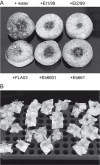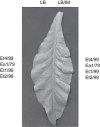Hypersensitive response and acyl-homoserine lactone production of the fire blight antagonists Erwinia tasmaniensis and Erwinia billingiae
- PMID: 21261861
- PMCID: PMC3815248
- DOI: 10.1111/j.1751-7915.2008.00043.x
Hypersensitive response and acyl-homoserine lactone production of the fire blight antagonists Erwinia tasmaniensis and Erwinia billingiae
Abstract
Fire blight caused by the Gram-negative bacterium Erwinia amylovora can be controlled by antagonistic microorganisms. We characterized epiphytic bacteria isolated from healthy apple and pear trees in Australia, named Erwinia tasmaniensis, and the epiphytic bacterium Erwinia billingiae from England for physiological properties, interaction with plants and interference with growth of E. amylovora. They reduced symptom formation by the fire blight pathogen on immature pears and the colonization of apple flowers. In contrast to E. billingiae, E. tasmaniensis strains induced a hypersensitive response in tobacco leaves and synthesized levan in the presence of sucrose. With consensus primers deduced from lsc as well as hrpL, hrcC and hrcR of the hrp region of E. amylovora and of related bacteria, these genes were successfully amplified from E. tasmaniensis DNA and alignment of the encoded proteins to other Erwinia species supported a role for environmental fitness of the epiphytic bacterium. Unlike E. tasmaniensis, the epiphytic bacterium E. billingiae produced an acyl-homoserine lactone for bacterial cell-to-cell communication. Their competition with the growth of E. amylovora may be involved in controlling fire blight.
© 2008 The Authors. Journal compilation © 2008 Society for Applied Microbiology and Blackwell Publishing Ltd.
Figures





References
-
- Von Bodman S.B., Bauer W.D., Coplin D.L. Quorum sensing in plant‐pathogenic bacteria. Annu Rev Phytopathol. 2003;41:455–482. - PubMed
-
- Bereswill S., Jock S., Geider K. Identification of Erwinia amylovora by growth morphology on agar containing copper sulfate and by capsule staining with lectin. Plant Dis. 1998;82:158–164. - PubMed
MeSH terms
Substances
LinkOut - more resources
Full Text Sources
Molecular Biology Databases

